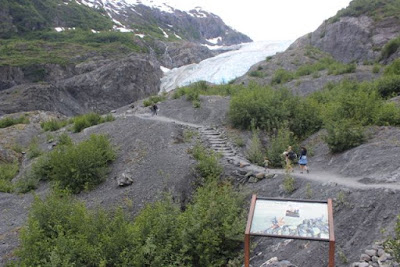We met Moshe at Congregation Beth Sholom Sunday where he gave a talk about how his community of Jews in Ethiopia walked for three weeks through Ethiopia to Sudan where they were in a refugee camp for 2 years before being able to complete their trip to Israel. He's in Anchorage because of the PACT (Parents and Children Together) program - which helps Ethiopian Jews get pre-school preparation to be ready for school. Moshe himself benefited from this and is now a PACT coordinator in his town. He was here, in part, to thank the people of Anchorage who have contributed to make this program possible. He mentioned after the talk that he very much wanted to see a glacier and we offered to help him find a glacier Monday.
 |
| See the whole strip at REOiv |
We decided to try for Exit Glacier and left in a light snow. The day reminded me of one of my favorite Calvin and Hobbes cartoons. Here are the key two panels from it.
Well, our world Monday was back in those old days when you could use color film, but the world itself was still black and white with only a few traces of the early colors showing.

Even without color, the drive to Seward is spectacular and our guest bubbled over with delight. Sharing Alaska is such an easy gift to give.
The roads were a bit tricky - and the drivers were getting used to the second day of snow. And the clouds were really low as we left Anchorage. Turnagain Arm was better, and things improved a bit as we went over Turnagain Pass. Eventually, we saw our first hint of sun after the Hope turnoff.
We took the turnoff to Exit Glacier, but didn't get very far and the road was closed. That would have been a much longer walk than we were prepared for, especially in several inches of fresh snow.
So back to the main road and into Seward. A stop at the harbor.
Then lunch at the Apollo. (There was color still inside.)

Then off to Lowell Point to do a little beach walk on the world famous white 'sand' beach.
(Didn't I say up top this was a black and white day?)

We decided there had to be a lot of fish in this location. Gulls were predominant, but there were cormorants and what appeared to be loons as well.
Then to the southern shore of Kenai Lake at Primrose campground. We could see sun on the distant mountains.
And Moshe got a spectacular shot of a bald eagle that flew low over us before taking a tree top perch. He was rightfully proud of the picture and I'll put it up when he sends it to me. [UPDATE Dec. 26: I posted the
eagle pictures here, but forgot to add a link here.]

A short walk through the woods from the Primerose campground trail in the fresh snow. The trees seemed to be dancing.
A little reflected sun and even some blue sky on the way back.
And then off to Portage to see if we can find some glacier. You could see about 30 feet out into the fogged in lake. So we took the trail to Byron Glacier. It was after 6pm and the sun had set and the snow was coming down thick. I hadn't been to Byron in many years. There isn't much left. But there was an ice cave on the lower right side of the dark front of the ice and other glacial shapes in the oncoming evening light and falling snow.
It was still not quite dark when we got back to the car. But once the car lights were on, it was, for all intents, dark out. And on the highway back, the snow was blowing hard toward us. Reflected in the headlights, it made it really hard to figure out where the road was. The rumble strips were great, but it wasn't easy to tell if you were too far to the left or the right.
I didn't quite get it from the back seat, but this does give you the sense of how hard it was to orient to the road. For once, the headlights of oncoming cars were helpful.
I hope there weren't too many typos. I'm tired.




















































